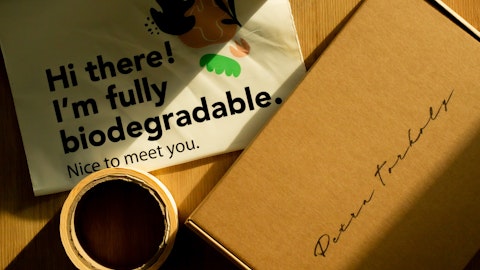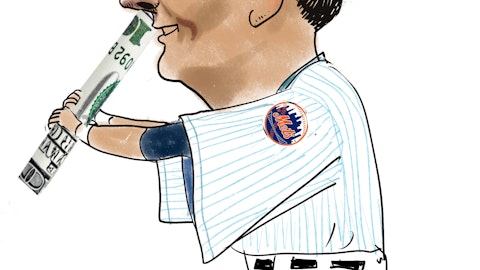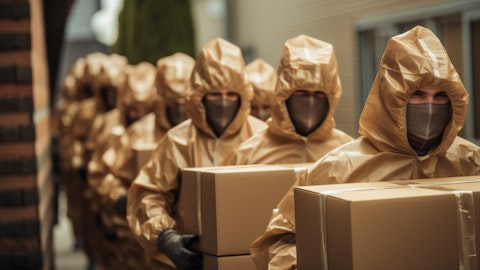So a lot of those targets were done. We made real good progress on the other nonfinancial goals as well. But again, many of those targets just aren’t ambitious enough or consistent with how we want to run the company going forward. But what I would tell you is that within Vision 2025, there were really 4 main objectives we laid out there. First, we knew we had to expand our innovation capability in a big way because we wanted to take advantage of being able to leverage the sustainability movement, which was now starting to take place here in the U.S. too. Our speakers will talk a lot more about how we’re doing that on Vision 2030 today, but that was a key initiative for Vision 2025. We had to realign our portfolio to move more with the consumer, which meant that we had to make some acquisitions of different businesses that would allow us to actually do that.
We had to capture a more reasonable value — for reasonable share, I should say, of the value that we are providing to our customers. And we had to invest in both our people and our assets. So those were the big things that we laid out there. If you look at Vision 2025, I think there were 21 targets that we assigned to it. But there were really 4 big things, strategic steps that we took that transformed our company during Vision 2025. The first, and I mentioned it already, was the IP consumer business. That was big for us. Because if you think about it, we had no exposure of any scale to the Foodservice business, which I think about Americans, they love mobility, they like being on the go. We didn’t have exposure that drive-through window. We didn’t even make a cup.
So you put that all together, that created a huge optionality for us in a whole new part of our business that we didn’t have before. Secondly, we need to grow our U.S. And European manufacturing capabilities. And what I mean by that was we put out a target as part of our Vision 2025 in terms of integration. And integration back when we laid out Vision 2025, kind of post the IP acquisition, was around 67%. We finished this year around 80%. So we’ve kind of grown that integration. But integration is really more was a yardstick for us in terms of how we measure. There were 2 things that we were really looking for in terms of building out our business and how we want to invest in it. First, we wanted to acquire businesses and markets that ultimately move with the consumer different than what our core business did.
The most recent example I can give you that is Bell. Maggie and her team have integrated that business now well into our business, but Bell brought consumer mailers. That was something we didn’t have before. And if you look at the prior 10 different acquisitions, every one of them brought something along those lines that helped us build out our portfolio, and I’ll show it to you in a minute and why it’s transformed the way that it has. Secondly and importantly, any business that we could find that had innovation capabilities that we could lever across a wider group of customers, both domestically or internationally was prioritized. The best example I can give to you of that was AR packaging. It was an absolute home run for us. Yes, it was a good business in its own right.
And it helped us get into Eastern Europe and build out our portfolio in a way that we couldn’t do on our own. But they were excellent at driving innovation and had a lot of new products there that you’re going to see as profile today that have allowed us to really scale across the globe. And that’s really what we need to be able to do as a consumer packaging company. So those 2 things were really what we were looking for there. Our customer relationships had to change. As I mentioned earlier, we bring more than just basic design elements and manufacturing. That’s what we were getting paid for before because that’s what we were charging them for. But when you think about the security supply we bring, the sustainability benefits, the innovation benefits, our customers know that what we bring is more than just raw materials and freight.
I had a boss one time who said, you don’t want your product to be treated like the commodity, stop acting like it is. And that’s really what we did and so we put this value-based pricing methodology in place. You guys know we’ve done it because the pricing has flowed through our P&L in a way you can’t follow based on just movements of paperboard. Maggie you go in a lot more detail there. So that balance is much more important for us going forward and something that is kind of core to our DNA, and you’ll see us continue to leverage that as part of our Vision 2030. Lastly, we saw a significant opportunity to generate an unmatched cost position in the most attractive part of the paperboard packaging market, and that’s really the recycled packaging, CRB.
And when you look at what we’ve done with Kalamazoo and the start up on that, it’s been nothing but a home run. Our cost position is unmatched. The grades that we have come off that machine are fantastic, and it’s integrated well into our business, and we’re leveraging those opportunities with customers as we speak. So listen, all of that really transformed the business very dramatically. And what I’m excited about with Vision 2030 today is that now as we lay this out, our ambitions will line up more with how we’re running the company and give you a framework so that you can hold us accountable going forward in terms of what we’re going to do. Very exciting for us. Now I’d like to tell you that everything we did with Vision 2025 really worked out the way we thought it.
We executed perfectly, there were no mistakes. But there were some things that we learned along the way there that really have helped us. Of course, this is September 2019, we dealt with COVID kind of — during that middle period of time. But even before that, we started having conversations with customers around innovation. We had some early success. And what ended up happening is customers will say, look, you did this good for us. So why don’t you do these 2 or 3 things, too. So we had to scramble in many cases, to add resources back into the company, something we did. Those are resources that are now part of our business and part of our innovation engine that you’ll hear Maggie talk a lot about. We also learned a lot of things during COVID.
Some of them were just heard. The first one I’ll point out to you was just kind of supply chain resiliency. I mentioned earlier that our customers care a lot about security of supply. More now than ever, the worst thing you can have if you’re a CPG is to have a stock outage. And our system had been optimized because for years, everything just kind of flowed nice and we were able to take costs down to the last penny, and our supply chain was long and expensive. You go through COVID. And then you add winter storm Uri in February of 2021, and we had a lot of challenges, a lot of force majeure letters, things we had to deal with. We had to build a more robust supply chain. And for a company that prides itself in execution, we talk that seriously.
And those are learnings that we will not forget. And our customers know it, too, and that is a part of what they buy, when they buy from Graphic Packaging. Also during COVID, we saw these massive shifts in overall demand, casual dining went way down. And after about a month or 2, you saw the foodservice side of the business really take off. Center of the store kind of came back. And again, we had run this kind of perfect [indiscernible] taking facilities down and optimizing our footprint to the point, our customers had some doing in that as well because they were pushing us for obviously, savings and things there as well, which is to be expected. But we learned that we got to have some flex capacity so that we can take care of customers’ demands as they shift and they will shift based on different demand pulses that they have to deal with out there.
And so you’ll see us not have everything on 3 shifts, we’re going to have some flex capacity that allows us to be able to do it. We’re not going to run everything 7 days a week because it doesn’t give us the ability to manage our business. We have 100 manufacturing facilities, and the balance on that will be reflected there. Sure, we’ll have some that run 7 days a week, 365 days a year. But there’s going to be a number of them that have that flex capacity. We also learned some things by spending $700 million in Kalamazoo essentially making and creating a brand-new mill. We went into that project thinking it was going to be totally an economic play. That’s how we introduced it. And we said, look, we had this unique opportunity to be able to take a bunch of costs out and drive a lot of really top line product through the marketplace, and we’re uniquely positioned because of the concentration we had with our Midwestern manufacturing facilities of paperboard.
But what we really found — we got those savings, but what we really found there was the grades and the quality coming off that particular manufacturing process is just superior to anything else that’s out there. You’ve heard us launch Rainier. Rainier is not even in a lot of the numbers you’re going to see today. I think it can be bigger than many of the innovations we have out there. It will compete with the very best paperboard out there and SBS is an example, the brightness, the coding characteristics, the smoothness, it’s fantastic. And we’ve got some early wins there. Maggie will talk about that when she’s up during her conversation. The point to make that around integration, though, and this is an important point to make, is integration for Graphic Packaging is a bit nuanced, and this is important.
If you think about what we’re doing in Kalamazoo, and you think about what we’re doing in Waco, if we have the opportunity to really grow with customers and generate excellent ROIC and consistent returns for shareholders, we are all in on integration. I’m going to say that again. We are all in an integration when it makes sense, consistency results in higher ROIC. However, when we don’t have a path to do that, like I just outlined with Augusta, then we’re better off putting that capital somewhere else. So you’ll see us put our capital where it will get the greatest return for shareholders, hard stop. So you’re not going to hear us talk a lot about our integration rates anymore because we’re really focused on our end-use markets. We’re a consumer packaging company.
But ultimately, that’s how I want you to think about our overall integration strategy in terms of how we’re building the business here going forward, and that’s exciting. And the implication for that really kind of comes in the form of — if you think about A&R packaging and that acquisition we made, for a minute. We got a lot of questions from a number of people, “Hey, you guys are going to integrate with AR.” And Steve and I answered it this way, at the time when we acquired that, we said, we have no plans to immediately do that, but over time, it could be — provide some optionality. The reality of it is, is as we’ve gotten deeper into this, and we’ve watched our European business, which generates outstanding results and excellent ROIC, we don’t need to integrate that business right now.
And it doesn’t make sense. Things would have to change very dramatically for us to see a scenario where we would have to backward integrate into Europe. That’s a big change. And I think the points I’m making on these things, we’ve learned through some of the things that we’ve come through is we form our opinions based on fact and how we actually generate returns for investors and shareholders over the long term. And that’s really why you want to buy a company that is constantly learning in that regard, and that’s Graphic Packaging. So I want to talk a little bit now about the company that we’ve actually built from the inside out. And I think if you look at the left-hand side, I think it’s — yes, on the left-hand side that you’re looking at there versus the right-hand side back to 2017, it’s a completely different company.
Look at that for a minute. Look at the different segments we have, and I talked about that march we were on and why we had to build the company out the way that we did. Our market participation strategies have just changed. We went from $4.4 billion to last year, $9.4 billion, and we’re going to build on that. And ultimately, if you think about that growth, some of that came from acquisitions, some of it came from innovation. We averaged about 2% sales growth over that period of time in our core markets and compare that against any other packaging substrate out there, whether it’s glass, aluminum, corrugated, that’s on par at the very best. And it’s really, really all driven by the innovation we see. And what you can see there and what I’m excited about is our ability to move with the consumer.
As the consumer moves, we’ll be there, and that’s the portfolio that’s really been generated and what we have. We have the scale to take care of the very biggest customers out there. If you’re a QSR operator and you have 7,000 stores in the — in North America. You’re probably going to do business with 2, maybe 3 packaging suppliers. That’s it. You don’t want to do it with 27. Why? You can’t control the quality. You can’t control the materials there. And we have the breadth and investment and the capabilities to take care of the very largest customers as well as take care of the regional business that we have. We’re uniquely positioned in that regard. That’s the company we’ve built over the last 7 years and it’s really going to be on display over the next few.
So let’s talk about what we’re doing and why. The bottom line is our core values have not changed. But we have, as we’ve transformed the business, our aspirations have grown alongside of our confidence. And that’s just — as you look at how that all kind of comes together, I’m going to introduce you a number of key elements of our Vision 2030 right now. And then the most important one, we start with this one here is really all around innovation. You’re going to be a global leader in consumer packaging. You have to be a leader in innovation. And we’re going to continue to invest in our people and our capabilities so that we’re the very best. Our Vision 2025 laid out some pretty big investments. I’ve already outlined what they were. But what will really define us with our Vision 2030 is the investments we’ve made in innovation and the people and capabilities that we execute on the scale that customers require.
We set 3 targets for this one, and they’re ambitious. The first one is 2% of our annual sales growth will come from innovation. We’ve done that over the last 2 years. You think about 2022 and you think about 2023, both those years, we grew over $200 million in innovation sales under very different market conditions. So we’ve demonstrated the ability to be able to do that. We’re pushing our teams to continue to find ways to build that funnel. And our confidence level here in 2024 to deliver the $200 million is high. If you think about the selling cycle for us, many of those things are already in the queue. And so we know exactly what they are, and they’re flowing through. And Maggie will talk about that in her prepared remarks a little bit as well.





